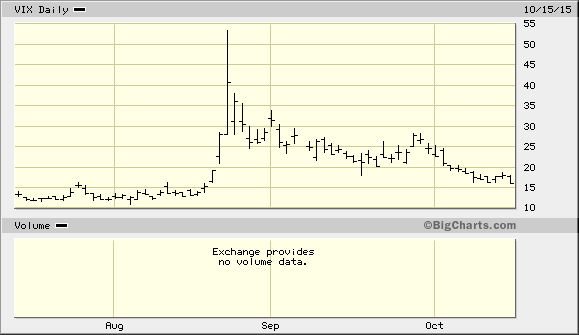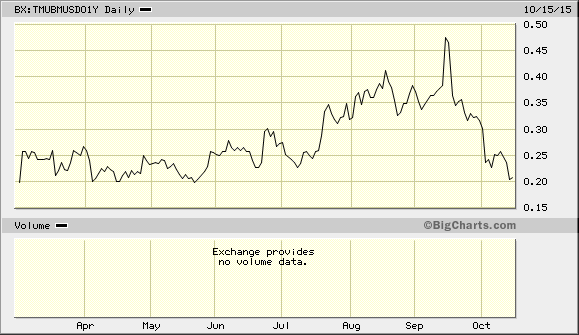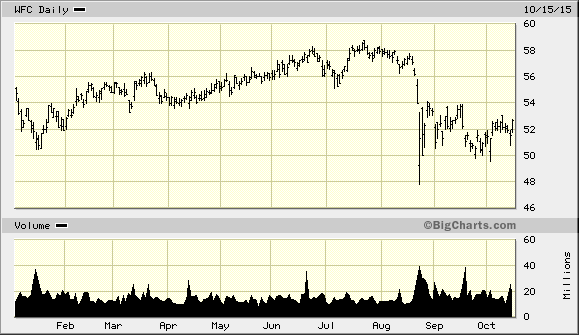CWS Market Review – October 16, 2015
“I hate weekends because there is no stock market.” – Rene Rivkin
Last week, I sounded the “All Clear” signal, and the market has responded. On Thursday, the S&P 500 closed at its highest level in eight weeks. The index has now risen for 10 of the last 13 days. Ever since Carl Icahn warned investors of danger ahead, the stock market has jumped 7.5%. I hope we get more warnings soon.
A few weeks ago, I was interviewed on Bloomberg TV, and I said that the VIX was too high given the market’s volatility. This was one of those times where I was hardly revealing some hidden fact—the math just didn’t add up. Since then, the VIX has crashed (see below). At one point, it fell for 10 straight days, and on Thursday, the VIX closed at its lowest level in nearly two months. Stocks are up, and expected volatility is down.
Fortunately, we can now focus on something important: earnings. Since our Buy List is focused on high-quality stocks, I look forward to earnings season. That’s when we can prove our mettle. In fact, we’ve already had our first earnings beat with Wells Fargo (WFC). But I need to warn investors: this is going to be a tough earnings season for companies that don’t please the expectations gods of Wall Street. We’ve already seen Walmart (WMT) get cut down for a 10% loss while Netflix (NFLX) lost more than 8%. There will be more.
Next week is going to be crucial for us. Seven of our Buy List stocks are due to report, including five on Thursday. In this issue, I’ll preview what’s in store. Before I get to that, though, I want to discuss the latest economic news. It now looks as if Wall Street doesn’t expect the Federal Reserve to do anything with interest rates for a few more months. As it turns out, all the warnings from the Fed this summer may have been for naught. Of course, this isn’t the first time the Fed has changed its plans.
No Rate Hike This Year Is Good for Stocks
On Wednesday evening, the Wall Street Journal posted an article by Jon Hilsenrath and Anna Louie Sussman titled “Fed Doubts Grow on 2015 Rate Hike.” Investors have learned to take notice when Hilsenrath writes because it’s widely assumed that he’s Janet Yellen’s main conduit to the investing community.
The article said that the odds of a rate hike coming from the Fed this year are falling fast. As you may recall, the central bank did everything it could this summer to prepare investors for a rate hike. Several times it hinted that an increase was coming soon.
The problem is the Fed expected the economy to accelerate in the back half of 2015, and that hasn’t happened. This week’s retail sales report wasn’t that good. The ISM report was weak, and the September jobs report was a bust.
This week, we got another inflation report and once again, consumer prices fell. In fact, the rate of deflation increased last month. That means that by doing nothing, the Fed has actually raised real interest rates. Some of this is the result of plunging commodity prices, but not all. The “core rate” of inflation is subdued as well.
A rate hike in 2015 is most likely off the table. The Fed has another meeting scheduled in two weeks. After that, there’s only one more meeting left for this year, which is on December 15-16. The futures market thinks there’s a 30% chance that rates will go up in December. It’s not until March that the futures market expects a rate hike, and that’s still only at 54%.
At the time, the Fed’s decision to forego a rate hike in September was controversial. Now it appears to be a no-brainer. In just a few weeks, the bond market has dramatically reversed course. On Wednesday, the 10-year Treasury closed at its lowest yield since April. One month ago, the one-year Treasury got to 0.47%. Now it’s back down to 0.22%.
What does this mean for us as investors? It all comes down to simple competition. The bond market is the stock market’s main rival. When the 10-year Treasury is yielding a measly 2% like it is now, that’s not much competition for stocks going at 14 or 15 times earnings. The S&P 500 will probably see its earnings fall around 5% this earnings season. Even with that decrease, stocks are still a bargain compared with the bond market.
Right now, 10-year TIPs (inflation-protected bonds) are going for 0.54%. My research has shown that TIPs historically aren’t a threat to stocks until they yield 2.43%. We’re still a long way from there.
There’s a concept in economics called the “non-accelerating inflation rate of unemployment” or NAIRU. Don’t let the name scare you; it’s actually pretty simple. NAIRU says that once the economy drops below X% unemployment, inflation will start heating up. So…what’s X? As turns out, no one knows. Economists had assumed X to be around 5.5%. We’re now down to 5.1%, and there’s still no inflation in sight.
Now folks are beginning to wonder if X is a lot lower than we’d thought. Maybe 4.5% or even lower. Why the change? That’s hard to say. Maybe demographics. Maybe technology. Or maybe the structure of the economy has changed in some way we don’t quite understand. As investors we don’t need to worry about why. The good news is that there’s no worry that inflation is going to strike us soon.
The chain of causality goes like this. Inflation leads to higher interest rates. Higher interest rates are tougher competition against stocks. That tougher competition leads to lower stock prices. Without that first step, I’m not so worried about the last step. Now let’s take a look at our first earnings report for this earnings season.
Wells Fargo Beat by a Penny per Share
On Wednesday, Wells Fargo (WFC) became our first stock to report results. Wells reported Q3 earnings of $1.05 per share, which beat Wall Street’s estimate by one penny per share. Overall, Wells had a decent quarter, but there are a few weak spots. Looking past that, Wells continues to be, in my opinion, the best-run large bank in America.
For Q3, the bank’s revenue rose to $21.88 billion, which beat estimates by $120 million. Total loans were up 7.7% while commercial and industrial loans were up 15%. That’s the good news. The downside is that Wells’s net interest margin came in a tad below 3%, which isn’t where I’d like it Of course, that’s the problem of living in a low-interest-rate world.
The bank has also been squeezed by dud loans to the energy sector. There’s been a lot of careless jabber on Wall Street about how large banks are much more vulnerable to bad energy loans than people realize. Truthfully, it’s an issue, but it’s hardly an earnings killer. Energy loans make up about 2% of Wells’s overall portfolio.
Wells conceded that the delinquency risk is higher than they initially estimated. Last quarter, the bank set aside $703 million for bad loans. That’s nearly double the number from a year ago, but the slowly-improving economy is helping consumers. Profits in community banking rose 6.5% to $3.69 billion, and profits in their brokerage unit were up 10% to $550 million.
Banks have what’s called an “efficiency ratio” which is expenses as a share of revenue. For Wells, their ratio last quarter was 56.7%. That’s within the bank’s target range.
The mortgage business has been a drag on Wells. Profits in that division fell by 2.7%, but I think we’ll see improvement from here. Earlier this week, Wells said it bought a big chunk of assets from General Electric (GE). GE’s strategy is to ditch its financial businesses.
Wells started off the year quite well for us, but it’s been lagging the market for the past two months. It’s been especially bad since the market turned towards Cyclicals about two weeks ago. This isn’t as much of a problem for Wells as it has been for the entire financial sector. This report tells me that Wells is doing just fine. Wells Fargo remains a strong buy up to $56 per share.
Seven Buy List Earnings Reports Next Week
Next week is going to be a busy one for us. Seven of our Buy List stocks are due to report, including five on Thursday. You can see a complete calendar of our earnings reports here. Let me preview what’s in store for next week.
On Tuesday, Signature Bank (SBNY) will report Q3 earnings. I said that Wells is the best-run big bank in America. Well, Signature is the best-run smaller bank. If they keep growing at this rate, soon they won’t be so small. Signature has now delivered 23-straight record quarters. They’ll almost certainly make that 24 next week. The consensus on Wall Street is for earnings of $1.82 per share.
One item that concerns me is that Signature has made many medallion loans for cab drivers, but Uber has hurt that business. Like Wells and energy, it’s an issue, but not a back-breaker.
On Wednesday, eBay (EBAY) is due to report its earnings. This will be the first earnings report for eBay without PayPal (PYPL). Wall Street expects 40 cents per share. Frankly, I’ve grown a bit frustrated with the online auction house. Amazon is squeezing them and the strong dollar has also taken its toll. ChannelAdvisor recently reported some poor metrics for eBay’s core business. I’m not ready to toss in the towel just yet on eBay, but I want hard evidence that business is getting better.
Thursday is the big day for us. Snap-on (SNA) and Wabtec (WAB) are due to report before the opening bell, while CR Bard (BCR), Microsoft (MSFT) and Stryker (SYK) will report after the closing bell.
Snap-on (SNA) has been one of our surprise winners this year. Through Thursday, the shares are up 17.4% YTD. The consensus on Wall Street is for Q3 earnings of $1.94 per share, which is probably a few cents too low. I also expect a nice dividend increase from Snap-on sometime next month. The stock is particularly attractive if you see it below $160 per share.
This summer, Wabtec (WAB) said that it’s targeting full-year earnings of $4.10 per share. That seems very doable. The company has already made $2.03 per share for the first half of the year.
Three months ago, CR Bard (BCR) not only beat earnings but raised its full-year guidance as well. For Q3, Bard expects earnings to range between $2.21 and $2.25 per share. For the full year, Bard is looking for earnings of $9.00 to $9.05 per share. I think they can beat both numbers. This is a solid stock.
Three weeks ago, I highlighted Microsoft (MSFT) as being an especially good buy below $44 per share. The bargain didn’t last long; shares of MSFT perked up and are now above $47 per share. I particularly liked the company’s 16% dividend increase from a few weeks ago. I have to say that I’m a bit cautious on this earnings report. While Microsoft has been struggling with its phones, the company has been doing well in other areas. Xbox, for example, is strong. The consensus for this earnings report is for 58 cents per share.
Stryker (SYK) has said it expects Q3 earnings to come in between $1.20 and $1.25 per share. It also raised its full-year guidance to a range of $5.06 to $5.12 per share. A lot of healthcare stocks have gotten beaten up lately, and Stryker suffered some as well. Between August 19 and September 28, Stryker dropped 11.6%. I think a lot of this was sector-focused, and the stock has started to recover. Look for another good earnings report from Stryker.
That’s all for now. Next week will be dominated by earnings. The big day for us will be Thursday, when five of our Buy List stocks are due to report. There’s not much in the way of econ reports next week, but I’ll want to see if the initial jobless claims can make a fresh four-decade low on Thursday. Existing homes will also come out on Thursday. Be sure to keep checking the blog for daily updates. I’ll have more market analysis for you in the next issue of CWS Market Review!
– Eddy
Posted by Eddy Elfenbein on October 16th, 2015 at 7:08 am
The information in this blog post represents my own opinions and does not contain a recommendation for any particular security or investment. I or my affiliates may hold positions or other interests in securities mentioned in the Blog, please see my Disclaimer page for my full disclaimer.
- Tweets by @EddyElfenbein
-
-
Archives
- April 2024
- March 2024
- February 2024
- January 2024
- December 2023
- November 2023
- October 2023
- September 2023
- August 2023
- July 2023
- June 2023
- May 2023
- April 2023
- March 2023
- February 2023
- January 2023
- December 2022
- November 2022
- October 2022
- September 2022
- August 2022
- July 2022
- June 2022
- May 2022
- April 2022
- March 2022
- February 2022
- January 2022
- December 2021
- November 2021
- October 2021
- September 2021
- August 2021
- July 2021
- June 2021
- May 2021
- April 2021
- March 2021
- February 2021
- January 2021
- December 2020
- November 2020
- October 2020
- September 2020
- August 2020
- July 2020
- June 2020
- May 2020
- April 2020
- March 2020
- February 2020
- January 2020
- December 2019
- November 2019
- October 2019
- September 2019
- August 2019
- July 2019
- June 2019
- May 2019
- April 2019
- March 2019
- February 2019
- January 2019
- December 2018
- November 2018
- October 2018
- September 2018
- August 2018
- July 2018
- June 2018
- May 2018
- April 2018
- March 2018
- February 2018
- January 2018
- December 2017
- November 2017
- October 2017
- September 2017
- August 2017
- July 2017
- June 2017
- May 2017
- April 2017
- March 2017
- February 2017
- January 2017
- December 2016
- November 2016
- October 2016
- September 2016
- August 2016
- July 2016
- June 2016
- May 2016
- April 2016
- March 2016
- February 2016
- January 2016
- December 2015
- November 2015
- October 2015
- September 2015
- August 2015
- July 2015
- June 2015
- May 2015
- April 2015
- March 2015
- February 2015
- January 2015
- December 2014
- November 2014
- October 2014
- September 2014
- August 2014
- July 2014
- June 2014
- May 2014
- April 2014
- March 2014
- February 2014
- January 2014
- December 2013
- November 2013
- October 2013
- September 2013
- August 2013
- July 2013
- June 2013
- May 2013
- April 2013
- March 2013
- February 2013
- January 2013
- December 2012
- November 2012
- October 2012
- September 2012
- August 2012
- July 2012
- June 2012
- May 2012
- April 2012
- March 2012
- February 2012
- January 2012
- December 2011
- November 2011
- October 2011
- September 2011
- August 2011
- July 2011
- June 2011
- May 2011
- April 2011
- March 2011
- February 2011
- January 2011
- December 2010
- November 2010
- October 2010
- September 2010
- August 2010
- July 2010
- June 2010
- May 2010
- April 2010
- March 2010
- February 2010
- January 2010
- December 2009
- November 2009
- October 2009
- September 2009
- August 2009
- July 2009
- June 2009
- May 2009
- April 2009
- March 2009
- February 2009
- January 2009
- December 2008
- November 2008
- October 2008
- September 2008
- August 2008
- July 2008
- June 2008
- May 2008
- April 2008
- March 2008
- February 2008
- January 2008
- December 2007
- November 2007
- October 2007
- September 2007
- August 2007
- July 2007
- June 2007
- May 2007
- April 2007
- March 2007
- February 2007
- January 2007
- December 2006
- November 2006
- October 2006
- September 2006
- August 2006
- July 2006
- June 2006
- May 2006
- April 2006
- March 2006
- February 2006
- January 2006
- December 2005
- November 2005
- October 2005
- September 2005
- August 2005
- July 2005



 Eddy Elfenbein is a Washington, DC-based speaker, portfolio manager and editor of the blog Crossing Wall Street. His
Eddy Elfenbein is a Washington, DC-based speaker, portfolio manager and editor of the blog Crossing Wall Street. His